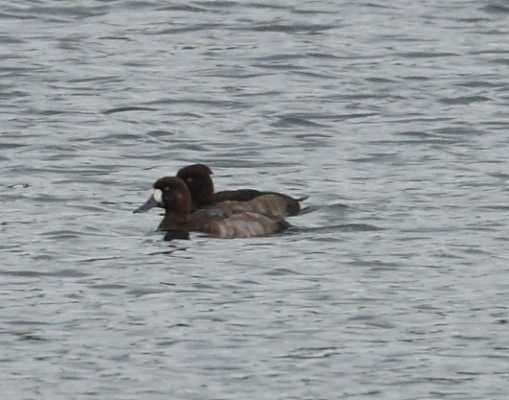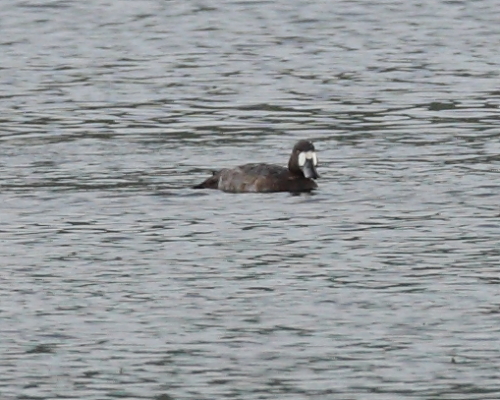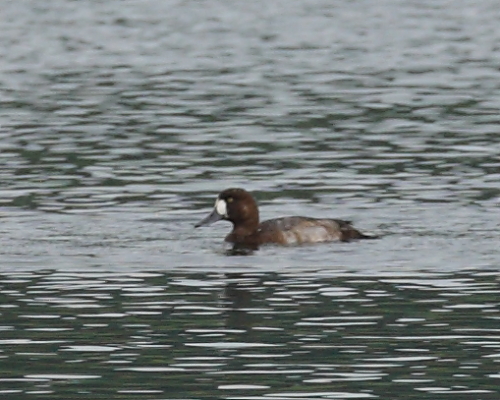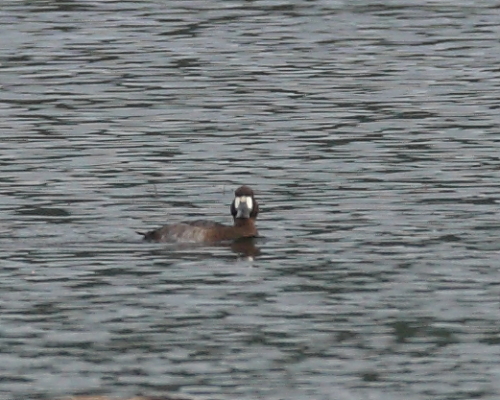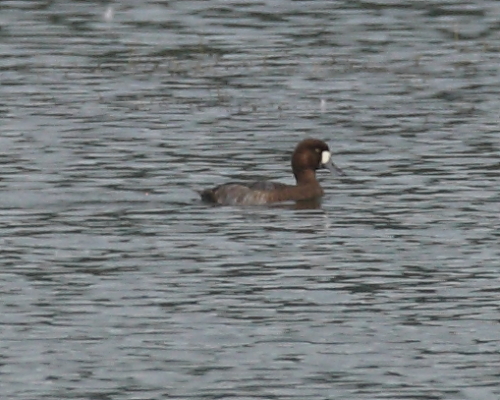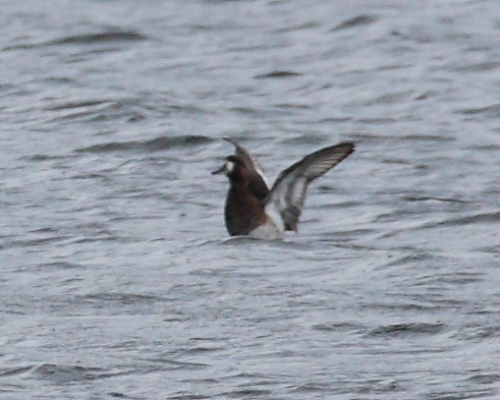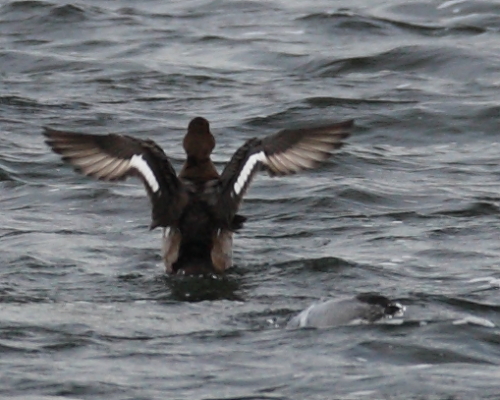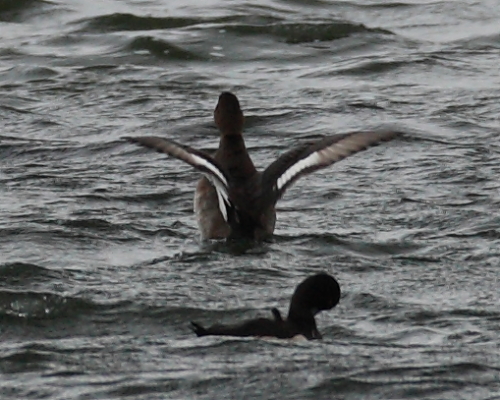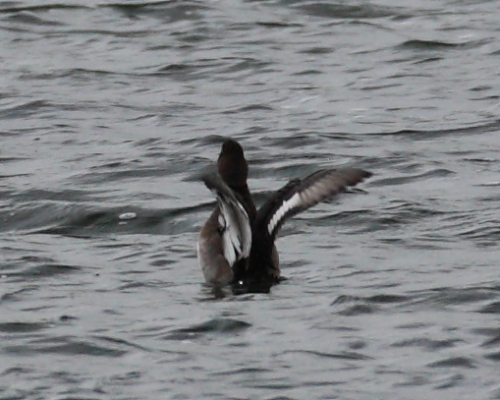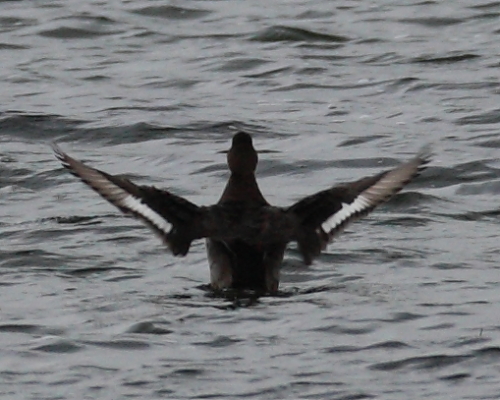Blagdon Lake Birds
October (part 1) 2013 News
In the coming weeks I'll be:
- Leading a walk at Blagdon Lake for Minehead U3A Bird Group on Friday 8th November.
- Talking on 'The Natural History of Blagdon Lake' to Bristol Naturalists Society (Ornithology Group) on Wednesday 13th November at the Guide Association Hall, Westmoreland Rd, Westbury Park, Bristol. Start 1930 hrs.
- Talking on 'The Biodiversity of Blagdon Lake' to Bath Natural History Society on Monday 2nd December at BRLSI, Queens Square, Bath. Start 1930 hrs.
- Talking on 'Blagdon Lake' to Weston-super-Mare RSPB Group on Thursday 5th December at St Paul's Church Hall, Walliscote Road, Weston-super-Mare (visitors welcome, admission £3). Start 1930 hrs.
Tuesday 1st October [Overcast and misty]
Let's start with news that the elusive Great White Egret Ardea alba was at Top End again this morning, though only showing intermittently, and the juvenile Glossy Ibis Plegadis falcinellus is still spending time feeding between Pipe Bay and around the Lodge to Home Bay. When I left at about 1330 hrs it was feeding by the fishing jetty and showing very well. At Top End I counted 77 Northern Pintail Anas acuta, 14 Ringed Plovers Charadrius hiaticula, 4 Common Snipe Gallinago gallinago, and saw a Dunlin Calidris alpina and the juvenile Little Stint Calidris minuta on Wookey Point. A Peregrine Falcon Falco peregrinus flew past me at Wood Bay Point as I was heading towards Top End hide.
This evening I walked a Nathusius's Pipistrelle Pipistrellus nathusii transect from the dam to Holt Copse. I probably recorded 2 - 4 Nathusius's, but haven't fully analysed the gps track and recordings yet. I did record a pass by a Lesser Horseshoe Rhinolophus hipposideros somewhere near the Fishing Lodge entrance gate.
The water level has dropped again to 48% (Bristol Water website).
Wednesday 2nd October [Showers]
Early this morning the juvenile Glossy Ibis Plegadis falcinellus had relocated to Holt Bay, where it's been feeding all day. I also saw about 30 Meadow Pipits Anthus pratensis feeding on the shore in the weeds there too. The family of 5 (an adult and 4 juveniles) Egyptian Geese from Chew have finally touched down at Blagdon where I saw them first at Cheddar Water, then in front of the Lodge before I went to look at Top End. New in there was a juvenile Ruff Philomachus pugnax and 10 Northern Lapwings Vanellus vanellus, as well as the 14 Ringed Plovers Charadrius hiaticula, juvenile Little Stint Calidris minuta and Dunlin Calidris alpina. I only spotted a single Common Snipe Gallinago gallinago among the snoozing wildfowl and while I was counting Ringed Plovers for the umpteenth time, the Garganey Anas qurequedula swam through my field of view, as it did on the 25th Sept. in the same place.
In the afternoon, when I got back from visiting friends, I saw the Great White Egret Ardea alba at Top End (having been tipped off by Chris Stone that it was back), just in time to see it take off and fly east towards Chew. So, I consoled myself by walking up to Bell's Bush and counting 369 Eurasian Wigeon Anas penelope and 479 Northern Shoveler Anas clypeata. I saw small flocks of Barn Swallow Hirundo rustica and House Martin Delichon urbicum moving through during my time at the lake, and spotted 1st-winter Great Black-backed Gull Larus marinus green 'L42' from Normandy, France, again. Two Common Gulls Larus canus were among the Black-headed Gulls Chroicocephalus ridibundus during the late afternoon, the portent of things to come.
This evening I decided to try and find out where the Glossy Ibis is roosting. I found it at 1815 hrs in Pipe Bay, a favourite location, so thought it might just pop up into the Willows there, but no, it took off and headed straight up the lake towards Top End. I jumped into the car and followed. I settled into the Top End hide at dusk and saw it poking around on the mud before wading out onto a mud bank where, after a quick preen, it settled down and went to sleep at around 1855 hrs. While I was there, the Great White Egret also flew in and after a short period in the feeder stream it flew up into the Scot's Pines at Indian Country and settled on the outside of the wood at a height of 40-50 feet. However, the breeze was quite strong and after several readjustments, it settled just inside the wood at a height of some 20-30 feet. Two ♂ Tawny Owls Strix aluco were singing just behind the hide as I got in the car and drove home at 1920 hrs.
Thursday 3rd October [Overcast and showery with an easterly breeze]
The juvenile Glossy Ibis Plegadis falcinellus was in Holt Bay again early this morning, and at Top End I saw 12 Ringed Plovers Charadrius hiaticula, the juvenile Little Stint Calidris minuta, a Common Snipe Gallinago gallinago and 2 Dunlins Calidris alpina during a brief visit.
By early afternoon the Ibis had moved to Tiny's Shallow in front of the Lodge. Richard Mielcarek, Paul Williams and I all saw a juvenile Eurasian Hobby Falco subutteo at Top End where there were a few Migrant Hawkers Aeshna mixta flying in the rain. However, there has been no sign of the Black Swan today.There is a small amount of inflow to the lake, after all the rain, that is colouring up the water and most Eurasian Teal Anas crecca and Wigeon Anas penelope were out of the water on the mud. I had a count of the Northern Pintail Anas acuta that I could identify from the hide in the rain and made it 92 (my highest ever count, though well short of the record 180).
This evening I went down to Top End and saw the Great White Egret Ardea alba in what's left of Rugmoor Bay, as I drove to the hide. At 1901 hrs all the roosting ducks (mainly Northern Shoveler Anas clypeata) flew onto the water and the Glossy Ibis flew in to roost on the mud bank. Then, at 1904 hrs the Great White Egret flew along Indian Country bank and landed in one of the Scot's Pines where it seemed to settle down to preen.
There is a curious 'yellow-legged' gull that has been appearing in front of the Lodge recently and while I initially thought it was a Yellow-legged Gull Larus michahellis, I am beginning to think it might actually be a Herring x Lesser Black-backed Gull hybrid. I want to get a few pictures of it, but as yet, whenever I have the camera to hand it's way out of shooting range or nowhere to be seen.
Friday 4th October [Showers]
After heavy overnight rain and thunderstorms, I was hoping for something new today on my early morning visit. The Great White Egret Ardea alba was feeding alongside a Grey Heron Ardea cinerea in the middle of Long Bay when I drove along, but as soon as I stopped the car it flew off. At Top End there wasn't much change with 12 Ringed Plovers Charadrius hiaticula, the juvenile Little Stint Calidris minuta and a Dunlin Calidris alpina in front of the hide. When I left, the GWE was showing very well, fishing out in the middle of Top End with the Grey Herons and a Little Egret Egretta garzetta. Amazingly, I spotted the Garganey Anas qurequedula to the left of the hide again too. The juvenile Glossy Ibis Plegadis falcinellus, initially in Wood Bay, had flown to Holt Bay to feed and was also showing nicely under a brilliant rainbow. I don't know how I missed it yesterday, but the Black Swan Cygnus atratus was off Green Lawn with the Mute Swan Cygnus olor flock again this morning.
Mid-afternoon a second Dunlin was feeding with the shorebirds at Top End (thanks for the call Paul Williams) and Richard Mielcarek emailed later to say that the Glossy Ibis was showing very well at Pipe Bay (restricted viewing over the gate though) along with a Common Sandpiper Actitis hypoleucos.
I carried out a Nathusius's Pipistrelle Pipistrellus nathusii transect walk from Holt Bay to Top End and recorded at least one, possibly two. I also saw the Glossy Ibis settling down to roost in the usual spot, but couldn't see the GWE from where I was standing at Rainbow Point, though it may have been hidden.
Saturday 5th October [Sunny and warm]
There's nothing new to report apart from the significant reduction in Northern Pintail Anas acuta numbers to half that of Thursday (now 46), a Northern Wheatear Oenanthe oenanthe at Green Lawn (thanks to Simon Isgar for the news), and the fact that the Great White Egret finally seems to have taken its leave.
The mobile juvenile Glossy Ibis Plegadis falcinellus is generally in the area around the Lodge and even looking looking the part in the sunshine today! At Top End there was an adult Little Egret Egretta garzetta, with 14 Ringed Plovers Charadrius hiaticula, the juvenile Little Stint Calidris minuta and a Dunlin Calidris alpina on Wookey Point, and 10 Northern Lapwings Vanellus vanellus at Hellfire Corner.
I have been asked several times recently "what's the rarest bird we've had at Blagdon Lake." So, for a bit of fun, I've done some digging around and if we were to take the number of occurrences in Great Britain up to the end of 2012 as our definition, then the Top 10 would come out as:
- Sharp-tailed Sandpiper 32 occurrences
- Black-winged Pratincole 36
- Pied-billed Grebe 40
- Franklin's Gull 67
- Marsh Sandpiper 138
- Squacco Heron 153
- Lesser Scaup 165
- Long-billed Dowitcher 238
- Baird's Sandpiper 248
- American Golden Plover 279 (to end 2011 only)
I did a Nathusius's Pipistrelle Pipistrellus nathusii transect walk again this evening and looked to see if the GWE and Glossy Ibis roosted at Top End before I started, but I saw neither. However, I did see a Barn Owl Tyto alba during the walk and recorded 2 Nathusius's and, of note, a Lesser Horseshoe Bat Rhinolophus hipposideros.
Sunday 6th October [A beautiful sunny and warm autumn day]
What a fantastic day to be out and about. The juvenile Glossy Ibis Plegadis falcinellus is still present and usually to be found between Pipe and Holt Bays. Aside from the ibis and an adult Yellow-legged Gull Larus michahellis, it's very quiet today, with the shorebirds having cleared out at last. I counted 14 Northern Lapwings Vanellus vanellus, saw 4 Eurasian Siskins Carduelis spinus at Hellfire Corner and heard several Northern Ravens Corvus corax flying overhead. There were a few more Common Gulls Larus canus at Top End as they start to arrive for the winter, and quite a few migrating Red Admirals Vanessa atalanta heading south over the lake towards the Mendips though, perversely, I did see a couple heading north too - reverse migration Keith? The Black Swan Cygnus atratus was off Green Lawn.
I did a Nathusius's Pipistrelle Pipistrellus nathusii transect walk this evening and heard a Common Sandpiper Actitis hypoleucos at the dam, recorded 2 Nathusius's (one at either end of the dam) and a Lesser Horseshoe Bat Rhinolophus hipposideros along Butcombe Bank.
Monday 7th October [Sunny and warm most of the day]
I shall start by confirming that the juvenile Glossy Ibis Plegadis falcinellus has been at the lake all day, as have I, and that the only other birds of note were a group of 7 Skylarks Alauda arvensis that flew over, a Little Egret Egretta garzetta at Top End, 25 Northern Lapwings Vanellus vanellus, a Northern Wheatear Oenanthe oenanthe and the Black Swan Cygnus atratus.
However, at about midday while checking ducks from Bell's Bush I picked up a ♀ Aythya that looked quite interesting. So, I drove back to Wood Bay Point to get a slightly closer view and see if my initial impression of a possible Lesser Scaup Aythya affinis was borne out. I scrutinised the bird for about half an hour and was joined by Robert Billingsley, who unfortunately had broken his scope earlier, before I rang Richard Mielcarek to see if the 'Chew Boys' wanted to come and take a look too. He came over with Andy Davis.
My impression was that the bird was the size of a Tufted Duck Aythya fuligula or very slightly larger. The head was dark brown with a large white facial blaze, pale ear patches, a yellow-brown iris, dark brown neck and upper breast, pale and blotchy side panels that are concolorous with the front of the mantle, dark brown tertials, primaries and tail, and a white belly. The legs appear to be grey-black. After seeing the bird flap its wings on a number of occasions during my 4.5 hour observation I was no clearer to clinching the upper wing pattern, until at 1635 hrs, Richard Mielcarek and I momentarily saw a wing stretch that we agreed showed a white secondary panel and grey primary panel. The head shape is sleek and rounded most of the time when the bird is feeding and just now and again appears to show a flat crown with a high point at the rear. It is this, the size and the general feel that make me wonder about it... could it be a hybrid? At present, the consensus seems to be that, on balance, it probably is a ♀ Lesser Scaup.
I'm putting it out there for others to come and take a look tomorrow, hopefully, and just maybe we'll get some closer views and have the opportunity to take some pictures.
Tuesday 8th October [Sunny spells with drizzle setting in at lunchtime]
The juvenile Glossy Ibis Plegadis falcinellus has been feeding in Long Bay this morning and I saw it again at dusk in Wood Bay.
The putative Lesser Scaup Aythya affinis showed quite well for an hour or more close in to Wood Bay Point this morning (about 150-200 metres range) before drifting way out towards Rugmoor Point. Chris Craig and Chris Stone came to take a look with Richard Mielcarek and I, and although many of the field marks are right for Lesser Scaup, no-one is prepared to say it is one - it just doesn't seem to have the right jizz, especially around the head. Here are some, admittedly poor, pix taken with my 600 mm lens when it was nearest to the bank.
Hopefully, the pictures grabbed today give a sense of the size of the bird when compared to a Tufted Duck Aythya fuligula, the variable head shape (mostly taken when actively feeding) and the bill. There is a picture of a ♀ Lesser Scaup head in my species account taken in September for comparison.
I carried out the fifth and last October Nathusius's Pipistrelle Pipistrellus nathusii transect this evening between the Hatchery and Rugmoor Bay. In a small area behind the pines at Indian Country there were a host of bats flying including a single Nathusius's. It was a real hot spot.
Wednesday 9th October [Overcast with occasional sunny spells and decidedly cooler]
The juvenile Glossy Ibis Plegadis falcinellus was asleep on Home Bay Point at lunchtime, and in front of the Lodge there was a Northern Wheatear Oenanthe oenanthe and 2 juvenile Dunlins Calidris alpina. Todays cool breeze had a late autumn feel to it, with a few more Northern Lapwings Vanellus vanellus in (I counted 32), and although the Black Swan Cygnus atratus is still present, many of the Mute Swans Cygnus olor were seemingly restless and flying around. A juvenile Peregrine Falcon Falco peregrinus was causing havoc among the wildfowl at Top End again, with ducks flying in all directions at one point.
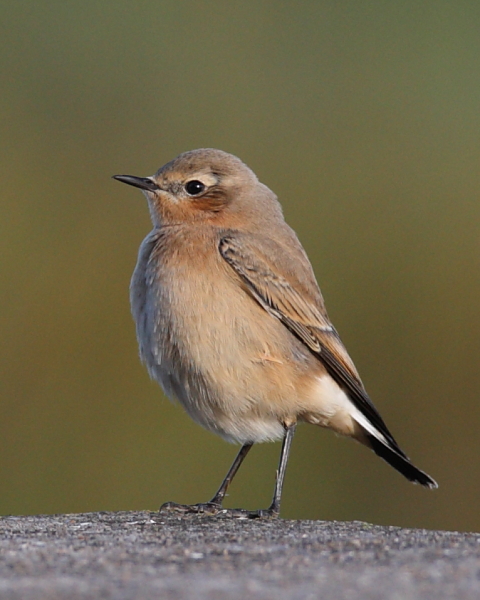
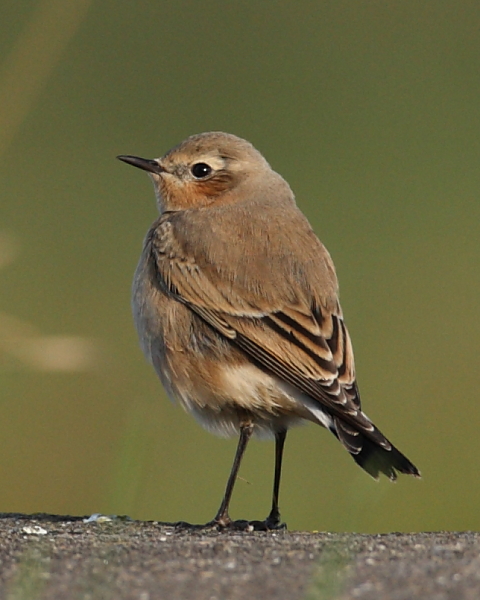
I've spent another 3 hours looking at the mystery Aythya since I last wrote and have got some more pictures to help or confuse the issue:
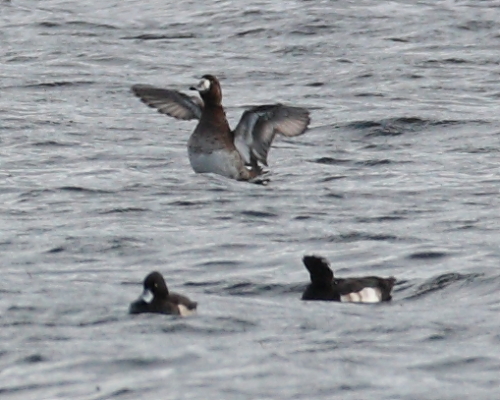
Left shows the underwing but also note the other wing where you can see a hint of the upperwing panel too. Right shows the underwing in better focus than yesterdays shots. It has been shown (e.g. Garner 2002, in Birding World 15: 506-508) that the underwing pattern of a Lesser Scaup does not match the upperwing pattern and if you click on these links you will see pictures on the University of Puget Sound Musem website : Upperwing and underwing. Likewise, here are links to Greater Scaup Aythya marila upperwing and underwing (admittedly of the Pacific race, taken in Washington State in December). In my opinion, the underwing looks okay for Lesser Scaup.
Keith Vinicombe, Andy Davis and I watched it together this morning and we all agree it ticks many of the boxes for Lesser Scaup Aythya affinis, but...
Thursday 10th October [Sunny and much cooler with a northerly breeze]
Late afternoon the juvenile Glossy Ibis Plegadis falcinellus was feeding around Wood and Holt Bays. There were 5 Dunlins Calidris alpina on Tiny's Shallow in front of the Lodge, only 8 Northern Lapwings Vanellus vanellus and a Little Egret Egretta garzetta of note at Top End, and I counted 77 Northern Pintails Anas acuta. I understand someone saw a Common Sandpiper Actitis hypoleucos and Yellow-legged Gull Larus michahellis at the lake today as well. I heard a Common Sandpiper calling at Wood Bay yesterday and saw the Yellow-legged Gull at Spinney Point but forgot to write them up.
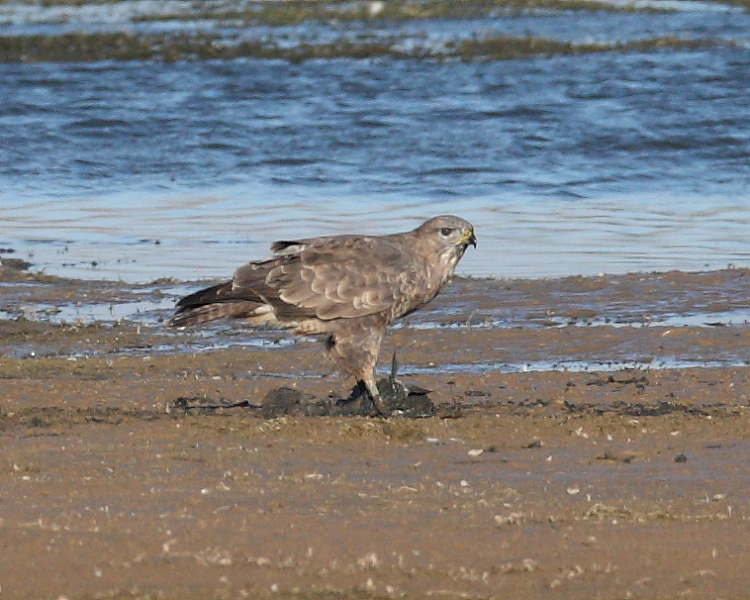
Roy Curber and I will be trying to do the WeBS count on Saturday morning starting at 0930 hrs, but with 'shedloads' of dabbling ducks present it will be a tall order, with half the team away at the moment. Does anyone fancy joining us to count a couple of species? All help, on a one-off basis with no future commitment, will be gratefully received.
The Bristol Water website is reporting the Blagdon Lake level to be 46%, down another 2% on last week. Soon, I shall have to rename the website 'Blagdon Puddle Birds'!
I was walking around lunchtime, from Lydford-on-Fosse to Bruton, and saw quite a few Red-legged Partridges and lots of Lesser Black-backed Gulls in the fields.
Friday 11th October [Sunny, cool and breezy]
The juvenile Glossy Ibis Plegadis falcinellus is now into the third week of its stay and, although not seen early on by Simon Isgar, it was back in Long Bay late morning and when I left again mid-afternoon. Aside from the ibis, it was very quiet this morning, with the Little Egret Egretta garzetta at Top End and a Yellow-legged Gull Larus michahellis in front of the Lodge the best birds noted. I understand there were large movements of Redwings along the coast but there was no evidence of this mid-morning at Blagdon - just one Skylark Alauda arvensis.
Here are some upperwing shots of the mystery ♀ Aythya taken today:
The upperwing was much easier to photograph today, in the north-easterly wind, and looks like a classic Lesser Scaup. I've noticed an additional feature in these pictures that is shown on the museum upperwings of Lesser Scaup and apparently not on Greater Scaup and that is the small white patch on a feather (secondary?) nearer the body. I can't say unequivocally that it is a difference between the two because there may be the faintest hint of a similar patch on one of the museum ♀ Greater Scaup upperwings, but it isn't evident on the others. Has anyone else noticed this, or, got photos showing it on either species, especially Greater Scaup? No field guides show this level of detail, including Sibley, and the photographic guide to Wildfowl of the World has no flight shots. I guess it's going to be another trawl through the internet pictures tonight, with the proviso that not all are labelled correctly anyway, of course!
I have put feeders up again at the Lodge and Ubley Hatchery entrance a couple of days ago and the birds are beginning to use them, so check them out occasionally.
Saturday 12th October [Mainly sunny and warmer than of late]
We got juvenile Glossy Ibis Plegadis falcinellus on the WeBS count for the first time this morning, which was some recompense for a monumental 5 hour effort by 84 years old Roy Curber and I. Other birds of note were a calling Common Greenshank Tringa nebularia, when we arrived, an adult Yellow-legged Gull Larus michahellis, a Little Egret Egretta garzetta at Top End, a single flyover Skylark Alauda arvensis and a couple of small flocks of Redwings Turdus iliacus.
Then there were the ducks... By far and away the biggest ever WeBS count I've done at Blagdon in 16 years, with over 6700 waterbirds comprising 1749 Eurasian Teal Anas crecca, 755 Mallard Anas platyrhynchos, 669 Northern Shoveler Anas clypeatus (a site record), 619 Eurasian Wigeon Anas penelope, 543 Tufted Duck Aythya fuligula, 208 Gadwall Anas strepera, 117 Common Pochard Aythya ferina and 109 Northern Pintail Anas acuta, not to mention the 1213 Common Coots Fulica atra and 92 Common Moorhens Gallinula chloropus and smaller numbers of other species.
The BTO website WeBS Report Online shows that Blagdon is on HIGH ALERT due to the 5yr short (-68%) and 25yr long term (-51%) decline in Eurasian Teal Anas crecca numbers. I think this probably reflects water level 'management' more than anything else, but don't have evidence to substantiate it at the moment. Nevertheless, today's count is a welcome return to form. Chew Valley Lake is on Medium Alert due to a short term fall in Northern Shoveler Anas clypeata numbers, so the record count at Blagdon today is worthy of note. Both species are very susceptible to disturbance and the exceedingly low water level means that it is too shallow for boats at Top End, and it is too weedy for bank anglers, so the birds remain undisturbed east of the line between Rugmoor and Rainbow Points (aside from low flying hot air balloons and Peregrine Falcons).
Sunday 13th October [Overcast with rain setting in at lunchtime]
Rich Andrews posted a tweet to say that a hot air balloon had spooked all the waterbirds late yesterday, but thankfully, with American birders Dale and Carolyn that I met in Alaska arriving on Tuesday, the juvenile Glossy Ibis Plegadis falcinellus was still at Home Bay Point this morning. There were 2 Little Egrets Egretta garzetta at Top End and a few more Mute Swans Cygnus olor, bringing the total to 56 (including 10 juveniles) today. The Black Swan Cygnus atratus is finding conditions to its liking and it won't be too long before the Bewick's (Tundra) Swans Cygnus columbianus bewikii arrive, and with the lake as it is, perhaps they'll stick around for a month or two as well.
Late afternoon Sean Davies saw the Glossy Ibis in Long Bay and a Common Sandpiper Actitis hypoleucos at Cheddar Water.
The YACWAG team were planning to finish checking the north shore bat boxes this afternoon, but with the rain setting in we decided to postpone it.
I see there is a message posted on the Bristol Water Fisheries website today by Tony Donnelly, the Assistant Fisheries Manager, that reads as follows:
"Despite our best intentions, Bristol Water Fisheries have been informed that it will not be possible to offer any extra fishing this winter due to licencing restrictions from Natural England (NE). As many anglers know, all of our lakes are classified under European Union frameworks as Sites of Special Scientific Interest (SSSI) and are Special Protected Areas (SPA) due to the important habitats they provide to bird species. In our specific case this simply means the appropriate paperwork would never be completed in time for fishing to take place into December. As a result we can now confirm the following dates in the fishing Calendar:
October 15th – Winter permit prices start, all brown trout to be returned unharmed.
October 31st – Boat fishing ends at Blagdon Lake.
November 10th – Boat fishing ends at Chew Valley lake.
November 30th – Bank fishing ends at all waters.
Although deeply disappointed that we are unable to extend what has been a magnificent season, negotiations will continue with NE and it is our hope that in future we will be in a position to increase fishing activity on our lakes."
Although I haven't fished for five years, I can tell you that the season has already been extended in recent times resulting in the season starting earlier and finishing at least a month later than when I fished regularly. We can add the (very probable) illegal stocking of Northern Pike Esox lucius into Chew and Blagdon that has also resulted in increased fishing activity during the winter months. Now, BW are stocking with triploid Rainbows (because there are restrictions on fish movement imposed by the Environment Agency), which ultimately means there will be no reason to have a close season at all for Rainbow Trout because they don't breed naturally and go out of condition. You can see where this is going.
Sadly, Natural England doesn't have a very good track record when it comes to protecting native bird species in the face of commercial interests e.g. the eradication of Hen Harrier as a breeding bird in England because of the perceived damage it does on Red Grouse moors, and now we have licences being extended to shooting estates to 'control' Common Buzzards because of the perceived damage they do to the 34 million, or so, (non-native) Pheasants introduced into our countryside.
I understand why the BW fisheries team may wish to increase the length of the season again, but I should like to think that Natural England will do the right thing and ensure that the insidious erosion of 'quiet time' for wildlife at the lakes will be considered when negotiations take place. If angling does become a year-round activity, we need appropriate checks and balances to be put in place in order that the wildlife value isn't diminished on the BW estate. I sincerely hope that NE and BW come to a suitable arrangement (viz. that commercial interests are suitably moderated) in order to safeguard the 'duck fest' that we have at Blagdon Lake currently, and that it will be there for generations to come, as provided for in legislation.
Monday 14th October [Sunshine and showers]
The juvenile Glossy Ibis Plegadis falcinellus was in what's left of Long Bay again this morning and there were 2 Little Egrets Egretta garzetta at Top End when a 3rd bird flew over, heading west, while I was at Bell's Bush checking through the wildfowl. I couldn't find the mystery ♀ Aythya at lunchtime, but it's not easy to find a single bird in the huge numbers packed into Top End. When I got back to the Lodge there was an adult Yellow-legged Gull Larus michahellis preening among a handful of large gulls, and while I was photographing it, a 2nd bird flew in. One has some fine streaking on the nape and the other has it restricted to around the eye and crown, which is why I knew there were two birds involved in recent sightings. I was a bit unsure about the bird with streaking on the nape because Pete Rock, who rings urban gulls locally, has warned us that there are some Lesser Black-backed x Herring Gull pairings that are producing hybrid young. However, I'm happy that both these birds are the 'real deal' having watched them fairly closely today.
Tuesday 15th October [Sunny and warm]
With the lake looking like a mirror, the juvenile Glossy Ibis Plegadis falcinellus was in Long Bay and the mobile Common Sandpiper Actitis hypoleucos at Cheddar Water again this morning. There were 2 Little Egrets Egretta garzetta at Top End and another in Long Bay - which with hardly any water and the sun beating down, had quite a Mediterranean feel to it!
I saw a single flyover Skylark Alauda arvensis at Wood Bay while I was looking for the mystery ♀ Aythya which was feeding right over at Rugmoor Point.
Most of the gulls were on the bank at Burmah Road and difficult to view, but our flock of naturalised Barnacle Geese Branta leucopsis was back to 15 again today having lost the extra bird that dropped in with them over the weekend. Could it have been a migrant? I guess we'll never know, but some Barnies turned up as far south as the Scilly Isles. There is a single bird that hangs around with the wintering Canada Goose Branta canadensis flock as well, but that was accounted for during our WeBS count.
I didn't see the Glossy Ibis late this afternoon but Alan Herring rang to say he saw it at Holt Bay on the way home from fishing while I was at Top End.
Bristol Water give the water level as 43% today.
